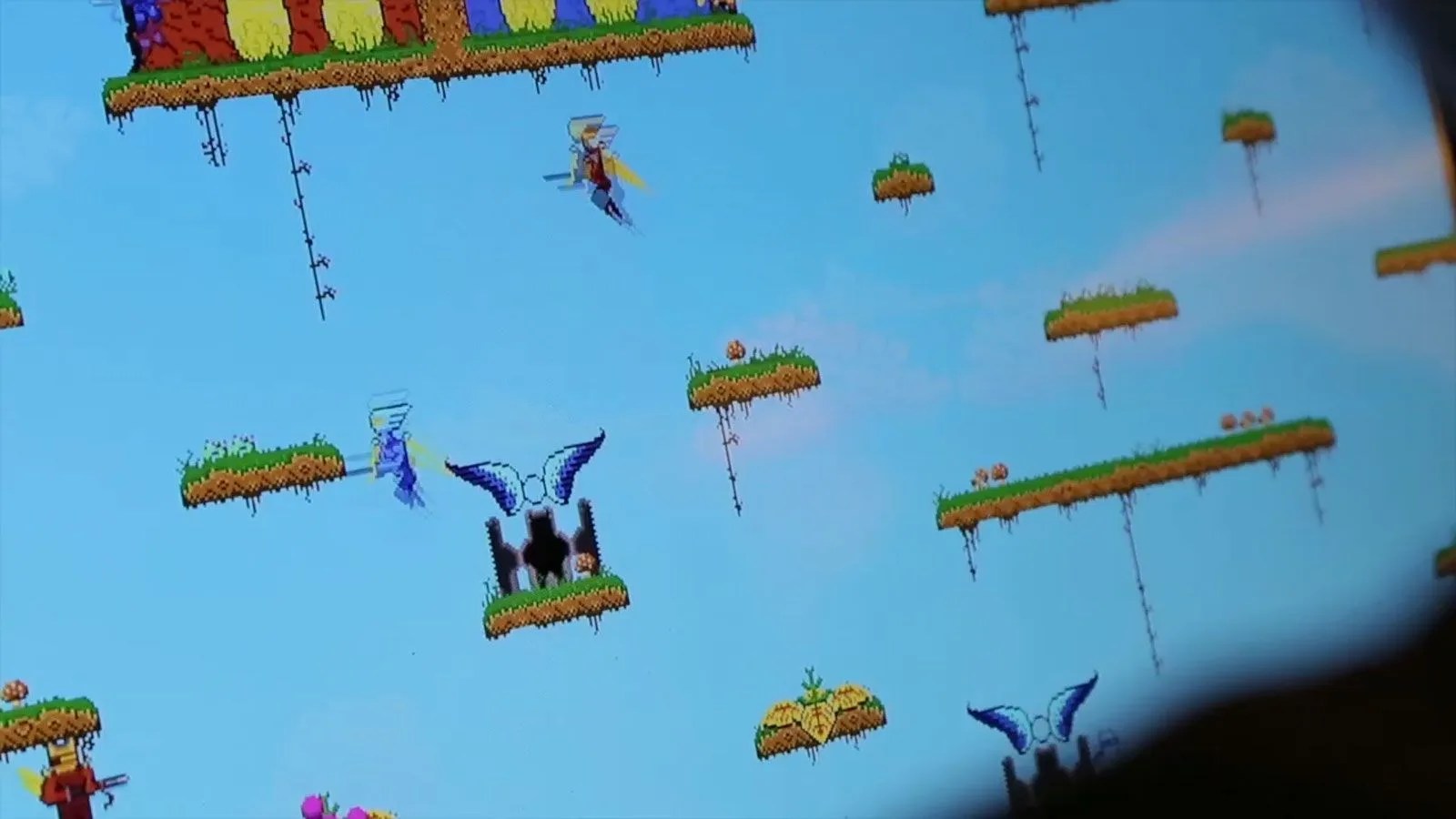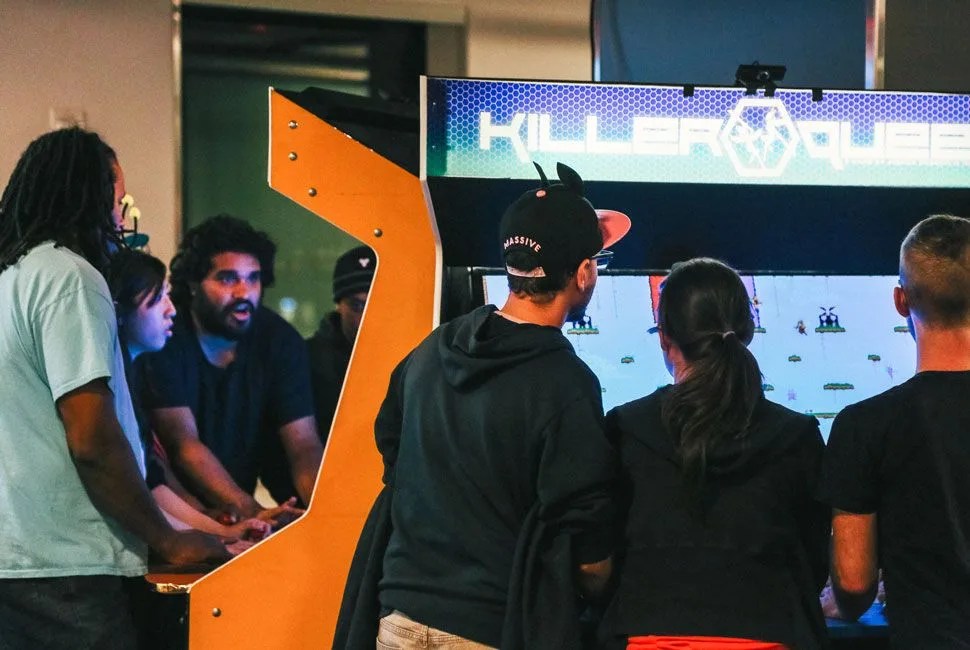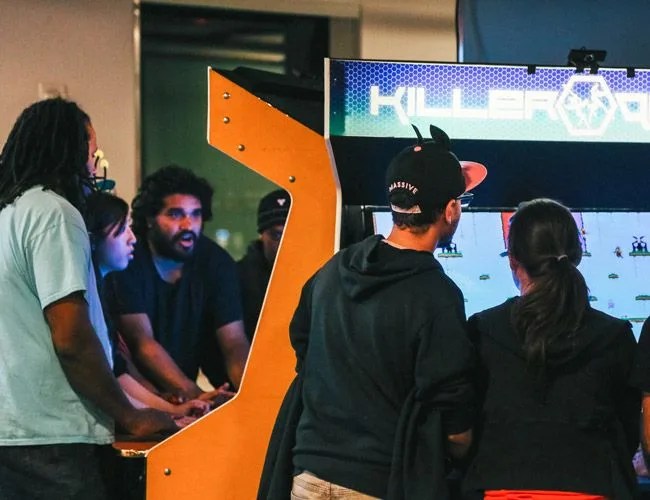
Up on the room’s big screen, there’s a vicious melee going on over a snail. Below a series of Mario World-esque leveled daises in front of a bright blue sky, a squat, gold-colored worker bee rides a purple snail toward his team’s side of the screen at an agonizingly slow crawl. Above him a trio of warrior bees and a fairy-like queen provide air cover, fighting off the blue, wasp-like attackers trying to kill the worker atop his shelled steed. One gold bee dodges through the air, dekes backward like a hockey center skirting a defenseman, gains height on its blue bogie, then drops down in a quick dive. As they collide, the blue bee disappears in a small cloud with an audible pop. The enraptured crowd of college kids and twentysomething gamers, already buzzing like a hive, lets loose a gentle roar of pleasure.
“The other team just isn’t responding,” says Zane Cacace, whose team, “Beediocre,” is on break after a win. He’s looking across the conference room of NYU’s Game Center at the closest of two groups of five players of the arcade game Killer Queen, all crowded around their side of a hulking two-sided arcade game cabinet, hammering away at buttons and joysticks. “They should be going full military,” Cacace says.
Unlike other arcade games, whose only sounds are intense tapping and quiet mutters, Killer Queen is lively and talkative, its 10 players chirping short commands to their teammates (“Queen’s protected,” “We need to push back!” “Fuck, on the base, I died”), laughing and yelling out, and occasionally taunting their opponents on the other side of the gaming cabinet. The game itself predicted the social fun in its pre-game screen, which is in on the gamer-nerd joke: “Killer Queen is best played with 10 players. It’s finally time to talk to strangers!”
To watch this particular matchup of the game is to gain a hard and fast lesson about the chaotic nature of Killer Queen, an arcade-style game that, with a social aspect, vibrant old-school aesthetic and complex school of strategy, belies easy definition. In fact, it’s unlike anything else in the gaming world right now.
“Killer Queen is best played with 10 players. It’s finally time to talk to strangers!”
Killer Queen is essentially an arcade version of capture the flag, but complicated by multiple ways to win. The combat-based chess game operates on a physics engine and game dynamic that borrow from the classic arcade game Joust, with its skate-style flying and combat wherein the lower player of two colliding opponents dies. In the Killer Queen match being played, the teams of workers, warriors and a single queen are fighting over the snail — which, in an 8-bit version of tug of war, wins the game if it is ridden all the way to one team’s side of the screen — but only because there are no berries left. The berries — they can only be collected by the workers, those grounded runners who are defenseless and rely on protection from their team’s flying warriors — start in piles throughout the level at the beginning of the game. They trigger a win if 12 are brought back to the teams’ home bases — but when dropped, the finite resource disappears, causing a “berry famine” that makes the win condition impossible. Hence, in this game, the battle over the snail. The queen, meanwhile, though fast and powerful, loses the game for her team if she’s killed three times. The three win conditions, along with players’ ability to switch between playing as a warrior and a worker bee (the queen plays a tactical role in that, as well) make this an ever-changing, combat-swirled game of three-pronged chess. (“Going military,” for instance, is a tactic involving all four non-queen members of a team playing as warrior bees in order to kill the opposing queen.) “You put enough stress on all the win conditions,” Cacace says, “the queen will move and you’ll kill it.”
Which is exactly what happens this game, with shocking abruptness. In the fluttering horde of flying insects, something gold drops onto something blue, the screen freezes, and the crowd yells out collectively. The blue queen is dead. Long live the gold queen. Game over. Gold wins. Both teams line up and shake hands.

“What we really want to see is the rebirth of people playing games in public spaces, like arcades,” says Nikita Mikros, who co-created the game along with fellow indie game designer Josh DeBonis. Both are at the NYU center, playing with their team, “BYOB,” tonight. “It gets you in, because it’s colorful and fun. But it also has really deep strategy and a very high skill ceiling. We used to be the best players, obviously, because we knew the game so well. But there are some really good players now. Me and Josh can’t touch them.”
The game has come a long way. Mikros and DeBonis created it as a “field game,” to be played with foam swords and ball props at New York’s “Come Out & Play” festival. But the game’s true potential was realized as a retooling of the old arcade game platform, played communally. Mikros and DeBonis pared the teams down from 8-on-8 to 5-on-5 and built the first game cabinet by hand in their garage over three long weekends. Today Mikros and DeBonis have their own indie design studio, BumbleBear Games, and they’ve produced around 20 Killer Queen machines in total, spread throughout NYC, Chicago, Portland, Columbus, Phoenix, Kansas City and San Francisco, plus a number of games bought privately at $12,000 plus tax each. (The Kickstarter office has one and is apparently viciously competitive.) Each city has a strong community of players with its own teams; when cities hold tournaments, like Chicago recently did, teams from across the country come together to pit their playing styles against each other and, just as importantly, it seems, to socialize.
“When people take notice of this game, they’ll see that games that force you to leave the house and play with friends have tremendous potential.”
Though the game is firmly entrenched in the underground community, it’s about to become airborne. The duo has teamed up with Raw Thrills, the maker of the popular bar shooter game Big Buck Hunter, to manufacture and sell an initial run of 20 more machines; there will be more once the company gets a sense for demand. “When people take notice of this game, they’ll see that games that force you to leave the house and play with friends have tremendous potential,” Hayden Cacace, Zane’s brother, says. Hayden is a mobile game designer who also plays on the Beediocre team; he calls Killer Queen his number one game to play right now, and the most influential on him as a designer.
The game has its struggles, too. Mikros and DeBonis have tried and failed to have Killer Queen installed in a location of Barcade, the popular gaming bar with locations in Manhattan, Brooklyn, and Philadelphia, but have been rejected, they say, because their game is not vintage. (A representative for Barcade declined to comment.) There remain only two public locations for the game in NYC — NYU’s gaming center and Chinatown Fair. “It’s sweatier there,” Cacace says of the Chinatown location, and filled with a different sort of crowd than NYU’s campus building. “A lot more tattoos.”
Regardless, Killer Queen has injected new life into an arcade gaming community that had been solidly focused on the past. It may serve as a foot in the door for others. BumbleBear Games is working on more arcade-style games with even larger teams, like Pixel Prison Blues, which pits 30 players against each other on a movie theater screen. “We just love creating a spectacle,” DeBonis tells me.
Around the room at NYU, the players gather in teams, talking strategy, practicing their fast finger-tapping on phone apps, having beers, laughing. Then the big screen lights up again. The players are tense at their joysticks; the crowd quiets, awaiting the action. Then the game starts, and everyone gives a cheer — there’s reason to “talk to strangers” once again.
